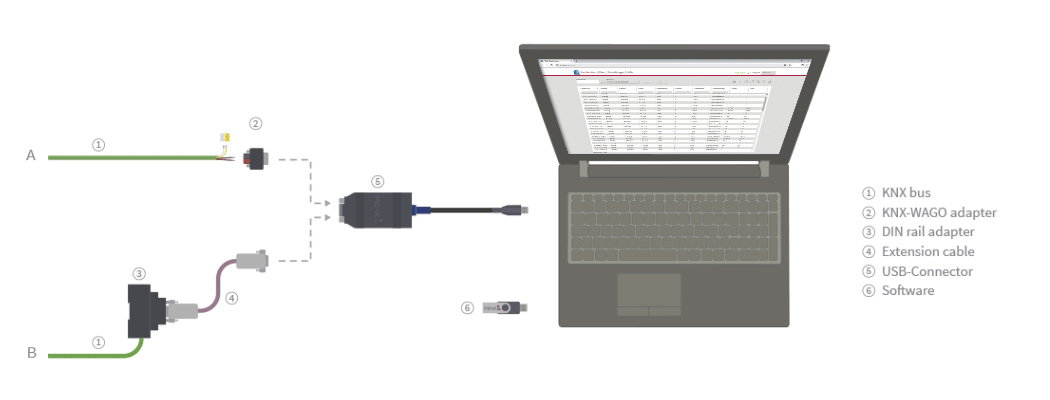USB-Connector incl. KNX-WAGO 243-211-Adapter (sealed)
The mobile PEAKnx USB-Connector with its including software package enables fast and simple communication with the knx bus from constantly changing locations. With the help of the USB connector, all KNX actuators can be parameterized via the ETS. In addition, the integrated IP router software allows access to the KNX bus with several programs. Via the supplied bus monitor, sources of error on the KNX bus can be identified more quickly.
More than a KNX USB interface thanks to helpful software
The USB connector allows to connect a Windows PC to a KNX network in a few simple steps with full bus communication capability. It can be used with ETS5 and higher and is compatible with Windows 7, 8, 8.1, 10 and 11. The included KNXnet/IP router software enables access to the KNX bus with several programs at the same time. In addition to the normal KNX compatibility, the USB-Connector has a KNX independent Windows driver. This makes the firmware of the KNX IP interface updateable via a PC and suitable for future standards.

Flexible use in different locations due to adapter concept
The KNX USB interface is the flexible companion for system integrators. It eliminates the need for an expensive KNX USB interface in the control cabinet. System integrators can access the respective KNX network with the help of the USB connector and their laptop. Instead of installing a KNX USB interface in the customer's control cabinet, only an affordable adapter remains there to which the mobile USB KNX interface is connected. With this adapter concept, system integrators gain a significant cost advantage, especially when many different customers and KNX projects are serviced.
Detect errors on the KNX bus in seconds
The included bus monitor significantly speeds up analysis and troubleshooting on the KNX bus. All KNX telegrams are displayed in the user-friendly interface, logged in tabular form and can be filtered according to various properties (such as source address, time and destination address). Filters can be composed of several filter properties and can also be applied or changed during the recording of the bus communication. It is possible to be notified directly by e-mail about certain events on the bus and to configure this as desired.
Software package at a glance
For the development of Smart Home projects or for later maintenance tasks - the supplied software simplifies the day-to-day work of system integrators! The package contains the following components:
1. IP-Router: In conjunction with the USB-Connector, the included software becomes a full-fledged IP-Router. The IP-Router can be used to access the KNX-network over any IP-capable device. You can also create and customise a filter table for incoming and outgoing messages in the software directly.
2. Bus-Monitor: The PEAKnx Bus-Monitor provides you with a clear overview of the KNX-network and offers extensive filter and analysis options.
3. ETS-Configurator: The ETS-Configurator allows you to parameterize and configure the KNX-network via the USB-Connector using ETS.
- USB-Connector
- KNX-WAGO 243-211-Adapter (unsealed)
- Installation USB flash drive
Current software, manuals and other documents with information about the USB-Connector can be found in our download area.
Supply
- On-USB: +5 V DC
- On-KNX: +24 V DC
- Max, USB power consumption: 100 mA
Connections
- USB: 1 x Type A USB-Connector
- Field bus: 1 x D-Sub (m), 9-pin
Software system requirements
- ETS-compatible: ETS 5 - 6
- Operating system: Windows 11, 10, 8.1, 8, 7 (32/64 bit)
- CPU: 1 GHz
- Main memory: 1 GB (32 bit)/2GB (64 bit)
- Hard drive space: 1 GB
- Graphics: DirectX 9 or higher
- NET version: ID 4.5.1 (included in Windows 11, 10, 8.1)
Dimensions
- USB-Connector size (W x H x D): 42,5 mm x 20,5 mm x 86 mm
- USB-Connector weight: 88 g
- Cable length: 65 cm
Environment
- Operating temperature: -40° C to 85° C
- Transport/Storage temperature: -40° C to 100° C
- Relative humidity: 15% to 90%, non-condensing
- Protection class: IP20 (acc. to EN 60529, DIN VDE 0470)
- EMC: Directive: 2014/30/EU, EN 61000-4-3:2011-04, EN 55011:2017-03




